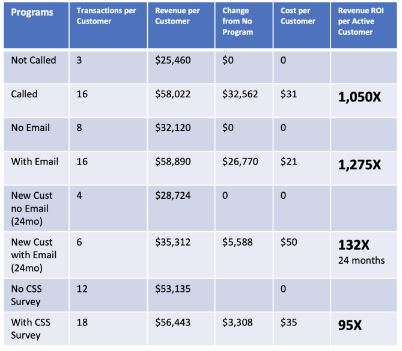Current End-User Customer Expectations
Our current market research work for machinery dealers clearly indicates that equipment owners of large fleets and small fleets expect parts and service to be provided within 24 to 48 hours. In some cities this expectation is less than 4 hours. They also expect to be informed and kept up to date when their expectations are not met. We are finding the number one reason for losing a customer in the equipment industry is mismanaging customer expectations and not keeping the customer informed proactively.
Unfortunately, many construction equipment and material handling dealers do not have the tools, key metric reports and forecasting ability to act and make intelligent decisions in a timely manner. They often rely on subjective metrics that are not linked to measurable operating and financial results. The lack of usable data causes management to be reactive, constantly scrambling to solve the latest problem, often unable to meet customer expectations.
Resources Available to Manage Customer Expectations
Today, automation is available for all equipment dealers (municipal, construction, material handling, heavy duty truck, fire apparatus) to meet and exceed their customer expectations, dramatically in order to drive profitable growth. The days of opinions, intuition and guessing to make business decisions are gone.
Automated and AI driven systems are now affordable for almost every dealer of any size. These systems can guide dealers’ employees to support their customers and meet expectations at every point of customer contact. Each point of contact can be automated with readily available programs and tools to help acquire, retain and delight customers.
The 5 major points of customer contact interactions are:
1. Outreach to Prospects and Customers
The most cost effective programs involve calling prospects and customers to identify decision makers, then followed up by sending emails to them consistently. The emails should feature the full range of the machinery you sell, plus aftermarket parts and service. These programs have the highest return on investment, especially when they are used to
The chart shown below provides results for one dealer that Winsby provides calling, email, and surveys for.
Return on Investment for Customer Outreach Programs
These numbers are one dealer’s results for the past 12 months.
Customers called by Winsby have purchased over 5 times more often and spent $32,562 more than customers who were not called over the past 12 months.
Customers receiving emails purchase 30% more often and spend $26,770 more than customers who are not receiving emails.
New Customers receiving emails purchase 2 times more often and spend $5,588 more than new customers who are not receiving emails.
Customers called to complete a customer satisfaction survey purchase 30% more often than those customers that have not taken the survey and spend $3,308 more.
Marketing by Customer

These programs with Winsby generate a return on investment, in terms of increased revenue, that ranges from 95X to 1275X for this equipment dealer.
The prospect and customer calling, email programs along with the customer satisfaction surveys were conducted by Winsbyinc.com. AI Analytics were used to identify markets and industries and to track the ROI for dealer marketing and sales programs. This software helps monitor marketing investments by program and is extremely useful in justifying dealer promotional budgets for the next year.
2. Identify prospect and customer leads who are interested in purchasing
First, customers’ contact information is collected, including direct phone numbers and emails by calling and verifying the information for decision makers at each company. The next step is to send emails a few times each month and include the decision makers on the list.
We use the updated customer contact information to determine their interest in your products and services by monitoring how often they visit your website and open emails. These customer activities can be tracked and scored. Management and sales reps can receive alerts when prospects visit your website and open your emails.
Because 60% of potential buyers will visit the dealer website before making personal contact, it’s good to know who is visiting, so you can follow up with them and find out what they need. Your website visitors are considered as “active leads”, and they need to be developed
3. Lead conversions
This process includes identifying customers who are new or who haven’t purchased parts, service, rentals, or machinery in over 8 weeks or have changed their purchase patterns. These changes in purchasing behavior indicate that these accounts and are at risk of being lost. This process also finds new prospects who are engaging with your website, emails, Google ads and social media.
Our software analyzes your invoices each month, then provides a list of customers who are at risk of being lost (“retention leads”). If customer purchase frequency drops, they are at risk of being lost and are possibly already moving to a competitor. A change in monthly purchase patterns or frequency is a strong indicator of where they are interested in purchasing their next machine.
The Last Purchase Report below includes every customer and shows the date they purchased last, along with their total revenues and number of orders, sorted by sales rep. These reports easily identify customers that haven’t purchased recently and need to be contacted by the dealership.
Lead customers should be contacted, since they have not purchased in 9 to 12 weeks. Lost customers have not purchased in over 12 months and would be difficult to reengage. New customers did not purchase in the prior 12 months but have purchased in the last 12 months.

When someone visits your website, opens your emails, or completes a form fill, the system sends an email to you automatically with information on the prospect, including their lead score, which indicates how engaged they are with your website and emails. Form fills are sent immediately via email, and the prospect automatically receives an email thanking them for the form fill and informing them you will contact them.
Below is a sample contact from the system. The lead score reflects how engaged the person is with emails and your website. Anything above 70 is someone who is considered to be engaged. The higher the score, the more active they have been opening emails and visiting your website.

4. Customer Satisfaction Surveys Are Essential to delivering service, parts, rentals, and equipment that meet the customers’ expectations
Winsbyinc.com conducts customer satisfaction surveys by phone to determine whether your company is meeting your customers’ expectations. Customers of dealers that Winsby provides this service for have customer retention rates that are 30% higher than the dealers who are not receiving this service.
Benchmark surveys are conducted periodically to determine exactly what customers and prospects expect service levels to be, what defines unacceptable service levels, and what is considered great service. Below is the weighted summary report for a Benchmark Survey for Equipment Dealers.
The criteria we explored to determine what is important to dealers included the following areas:

Proactive communication includes answering customers’ phone calls, texts and emails and tracking these interactions.
Winsby uses an automated tracking system for office phones, employees’ cell phones and website interactions. You can view reports online to see exactly what the engagement patterns are overall and the history of any engagement by customer and prospect.
For example, some equipment dealers are burning as much as 30% or more of customer calls by not answering the phone or letting them go into voicemail. If the dealership is busy and doesn’t answer the phone and is dumping calls into voicemail, less than 4% will leave a voicemail message. If your potential customer has another number to call, he is likely to call that next dealer.
Another example is “status calls.” Status calls occur when a customer calls asking for an update about a promised or expected delivery of parts or equipment, or completion of a shop repair. If the delivery or completion time will be longer than expected, it is important to advise the customer of the expected date for delivery. Proactively contacting customers to keep them informed of progress avoids status calls. Status calls are extremely expensive. They take 3 to 5 times longer to address than the time required to update customers proactively. The average equipment dealer loses 51% of their customers over a rolling 12-month period. The number one reason for a list customer is mismanaged expectations – not keeping the customer informed.
With these tools everyone can focus on providing the service and products needed to grow your equipment dealership.
- Customer retention increases
- Customer referrals grows
- Lead flow expands to replace lost customers and build your active customer count
- Prospects convert into customers more predictably when you know what they are interested and ready to purchase
- Engaging with your customers consistently and frequently ensures customer retention
Employee Engagement
The final key to an equipment dealer’s success is your positive engagement with your employees. This factor ultimately drives sales, productivity, and customer satisfaction.
Employees are the primary contact with each customer at every point of contact with your company:
- Inbound and outbound phone calls
- Emails
- Texts
- Products and service delivery
- Onsite sales and service calls
If your employees aren’t happy, trained, motivated, and equipped with the information and tools to do their job, the customer experience and, ultimately, customer retention will reflect their negative attitude with each customer experience that is not good.
Management’s role is to hire, train and retrain employees, and provide the resources they need to support their interactions with customers in order to meet the customer’s expectations.
Online ratings (Google 5 star) are visible to prospective customers and employees. These ratings are an indication of your ability to meet customer expectations and employee satisfaction. Over 60% of prospective customers and employees will not contact a dealer with Star Ratings below 3.0 Stars. Customers also see your Glassdoor and Indeed online ratings by your employees and often include these scores in their decision to contact you.
Shown below is a sample report on a dealer’s Ratings from Glassdoor and indeed.

The equipment industry depends on managers and employees who can operate independently, understand a situation, and take the initiative to solve any problem. This process can only occur when the information they need is readily available, easily understood, and tracked, so they can focus on what matters—the customer. Automation and outsourcing services make it all possible!
You can contact Debbie Frakes at 312-401-8651 or email her at dfrakes@winsbyinc.com.

